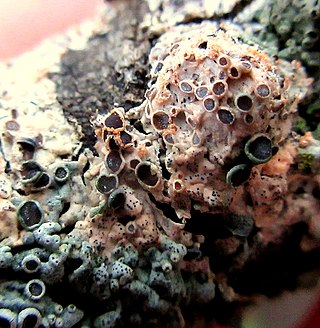
Ganoderma is a genus of polypore fungi in the family Ganodermataceae that includes about 80 species, many from tropical regions. They have a high genetic diversity and are used in traditional Asian medicines. Ganoderma can be differentiated from other polypores because they have a double-walled basidiospore. They may be called shelf mushrooms or bracket fungi.

Climacodon pulcherrimus is a species of tooth fungus in the family Phanerochaetaceae. It was first described as a species of Hydnum by Miles Berkeley and Moses Ashley Curtis in 1849. T.L. Nikolajeva transferred it to its current genus Climacodon in 1962, but research published in 2007 suggests it should be placed in a different genus. It is widely distributed in subtropical and tropical areas, where it grows on decomposing hardwoods, causing a white rot.

Geopyxis carbonaria is a species of fungus in the genus Geopyxis, family Pyronemataceae. First described to science in 1805, and given its current name in 1889, the species is commonly known as the charcoal loving elf-cup, dwarf acorn cup, stalked bonfire cup, or pixie cup. The small, goblet-shaped fruitbodies of the fungus are reddish-brown with a whitish fringe and measure up to 2 cm across. They have a short, tapered stalk. Fruitbodies are commonly found on soil where brush has recently been burned, sometimes in great numbers. The fungus is distributed throughout many temperate regions of the Northern Hemisphere. It is found in Europe, Turkey, and North America. Although it is primarily a saprotrophic species, feeding on the decomposing organic matter remaining after a fire, it also forms biotrophic associations with the roots of Norway spruce.

Dendrothele is a genus of fungi in the family Corticiaceae. According to a 2008 estimate, the genus has 36 widely distributed species.

Agaricus deserticola, commonly known as the gasteroid agaricus, is a species of fungus in the family Agaricaceae. Found only in southwestern and western North America, A. deserticola is adapted for growth in dry or semi-arid habitats. The fruit bodies are secotioid, meaning the spores are not forcibly discharged, and the cap does not fully expand. Unlike other Agaricus species, A. deserticola does not develop true gills, but rather a convoluted and networked system of spore-producing tissue called a gleba. When the partial veil breaks or pulls away from the stem or the cap splits radially, the blackish-brown gleba is exposed, which allows the spores to be dispersed.

Mycena californiensis is a species of fungus in the family Mycenaceae. It is a common and abundant species in the coastal oak woodlands of California, where it grows saprobically, feeding on the fallen leaves and acorns of various oak species. First described in 1860 by Berkeley and Curtis, the species was collected four years earlier during an exploring and surveying expedition. It was subsequently considered a doubtful species by later Mycena researchers, until a 1999 publication validated the taxon. Mycena elegantula is considered a synonym.

Podoserpula is a genus of fungi in the family Amylocorticiaceae. The genus contains six species including the type species, P. pusio, commonly known as the pagoda fungus. Species of the genus Podoserpula produce fruit bodies consisting of up to a dozen caps arranged in overlapping shelves, attached to a central axis. Its unique shape is not known to exist in any other fungi. The genus is known to occur in Australia and New Zealand, Venezuela, Madagascar, and New Caledonia.

Amanita ravenelii, commonly known as the pinecone lepidella, is a species of fungus in the family Amanitaceae. The whitish fruit bodies are medium to large, with caps up to 17 centimetres wide, and stems up to 25 cm (10 in) long. The cap surface has large warts and the stem has a scaly, bulbous base. The mushrooms have a unique chlorine like odor.

Lactifluus hygrophoroides is a member of the milk-cap genus Lactifluus in the order Russulales. It was first described scientifically by Miles Joseph Berkeley and Moses Ashley Curtis in 1859 as a species of Lactarius, and was historically known by this name until the systematics of milk-cap species were recently revised. It is a choice edible, although some report its taste to be mild.

Dacryopinax elegans is a species of jelly fungus in the family Dacrymycetaceae. It was originally formally described as Guepinia elegans by Miles Berkeley and Moses Ashley Curtis in 1849. George Willard Martin transferred it to the genus Dacryopinax in 1948.

Entoloma murrayi, commonly known as the yellow unicorn Entoloma or the unicorn pinkgill, is a species of fungus in the Entolomataceae family. First described from New England (USA) in 1859, the species is found in eastern North America, Central and South America, and southeast Asia, where it grows on the ground in wet coniferous and deciduous forests. The fungus produces yellow mushrooms that have a characteristic sharp umbo on the top of a conical cap. The mushroom is inedible and may be poisonous. Other similar species can be distinguished from E. murrayi by differences in color, morphology, or microscopic characteristics.

Mycena chlorophos is a species of agaric fungus in the family Mycenaceae. First described in 1860, the fungus is found in subtropical Asia, including India, Japan, Taiwan, Polynesia, Indonesia, and Sri Lanka, in Australia, and Brazil. Fruit bodies (mushrooms) have pale brownish-grey sticky caps up to 30 mm (1.2 in) in diameter atop stems 6–30 mm (0.2–1.2 in) long and up to a millimeter thick. The mushrooms are bioluminescent and emit a pale green light. Fruiting occurs in forests on fallen woody debris such as dead twigs, branches, and logs. The fungus can be made to grow and fruit in laboratory conditions, and the growth conditions affecting bioluminescence have been investigated.

Aureoboletus auriflammeus, commonly known as the flaming gold bolete, is a species of bolete fungus in the family Boletaceae. Described as new to science in 1872, it is found in eastern North America, where it grows in a mycorrhizal association with oaks. The caps of the fruit bodies are golden orange, with a yellow pore surface on the underside, and a reticulated (network-like) stem. The edibility of the mushroom is not known.
Pluteus aethalus is a species of agaric fungus in the family Pluteaceae. It is found in Cuba. The species was originally named Agaricus aethalus by Miles Joseph Berkeley & Moses Ashley Curtis in 1869, and later transferred to the genus Pluteus by Pier Andrea Saccardo in 1887. It is classified in Pluteus section Celluloderma, subsection Mixtini.
Sarcodon wrightii is a species of tooth fungus in the family Bankeraceae. It was first described in 1860 by Miles Berkeley and Moses Ashley Curtis as Hydnum wrightii. They were sent a specimen collected from Japan as part of the North Pacific Exploring and Surveying Expedition (1853–56). Rudolph Arnold Maas Geesteranus transferred it to the genus Sarcodon in 1967. The fungus produces roughly spherical spores that are tuberculate and measure 5.5–6.5 by 4.5–5.5 μm.

Lentinellus micheneri is a species of wood-inhabiting fungus in the family Auriscalpiaceae. It was first described in 1853 by mycologist Miles Berkeley and Moses Ashley Curtis as Lentinus micheneri. David Pegler transferred it to the genus Lentinellus in 1983. Like all species in its genus, it is inedible.

Loweomyces fractipes is a species of poroid fungus in the family Steccherinaceae, and the type species of the genus Loweomyces. It is a widely distributed species, found in North America, Europe, Central America, South America, and Korea.
Sarcodontia fragilissima is a species of toothed crust fungus in the family Meruliaceae. The fungus was originally described as Hydnum fragilissimum by Miles Joseph Berkeley and Moses Ashley Curtis in 1873. It was transferred to the genus Sarcodontia by T.L. Nikolajeva in 1961.
Cerocorticium molle is a species of crust fungus in the family Meruliaceae.

Ovicuculispora parmeliae is a widely distributed species of lichenicolous fungus in the family Bionectriaceae. It is parasitic on many foliose lichen species, particularly those in the family Parmeliaceae.
















